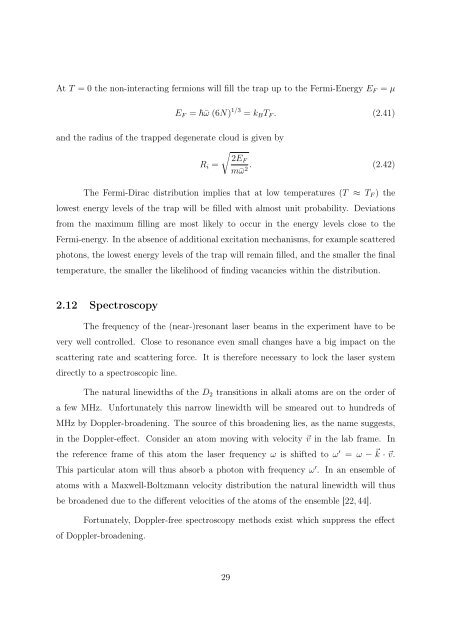Experiments to Control Atom Number and Phase-Space Density in ...
Experiments to Control Atom Number and Phase-Space Density in ...
Experiments to Control Atom Number and Phase-Space Density in ...
You also want an ePaper? Increase the reach of your titles
YUMPU automatically turns print PDFs into web optimized ePapers that Google loves.
At T = 0 the non-<strong>in</strong>teract<strong>in</strong>g fermions will fill the trap up <strong>to</strong> the Fermi-Energy EF = µ<br />
EF = ¯ω (6N) 1/3 = kBTF. (2.41)<br />
<strong>and</strong> the radius of the trapped degenerate cloud is given by<br />
<br />
2EF<br />
Ri =<br />
m¯ω 2.<br />
(2.42)<br />
The Fermi-Dirac distribution implies that at low temperatures (T ≈ TF) the<br />
lowest energy levels of the trap will be filled with almost unit probability. Deviations<br />
from the maximum fill<strong>in</strong>g are most likely <strong>to</strong> occur <strong>in</strong> the energy levels close <strong>to</strong> the<br />
Fermi-energy. In the absence of additional excitation mechanisms, for example scattered<br />
pho<strong>to</strong>ns, the lowest energy levels of the trap will rema<strong>in</strong> filled, <strong>and</strong> the smaller the f<strong>in</strong>al<br />
temperature, the smaller the likelihood of f<strong>in</strong>d<strong>in</strong>g vacancies with<strong>in</strong> the distribution.<br />
2.12 Spectroscopy<br />
The frequency of the (near-)resonant laser beams <strong>in</strong> the experiment have <strong>to</strong> be<br />
very well controlled. Close <strong>to</strong> resonance even small changes have a big impact on the<br />
scatter<strong>in</strong>g rate <strong>and</strong> scatter<strong>in</strong>g force. It is therefore necessary <strong>to</strong> lock the laser system<br />
directly <strong>to</strong> a spectroscopic l<strong>in</strong>e.<br />
The natural l<strong>in</strong>ewidths of the D2 transitions <strong>in</strong> alkali a<strong>to</strong>ms are on the order of<br />
a few MHz. Unfortunately this narrow l<strong>in</strong>ewidth will be smeared out <strong>to</strong> hundreds of<br />
MHz by Doppler-broaden<strong>in</strong>g. The source of this broaden<strong>in</strong>g lies, as the name suggests,<br />
<strong>in</strong> the Doppler-effect. Consider an a<strong>to</strong>m mov<strong>in</strong>g with velocity v <strong>in</strong> the lab frame. In<br />
the reference frame of this a<strong>to</strong>m the laser frequency ω is shifted <strong>to</strong> ω ′ = ω − k · v.<br />
This particular a<strong>to</strong>m will thus absorb a pho<strong>to</strong>n with frequency ω ′ . In an ensemble of<br />
a<strong>to</strong>ms with a Maxwell-Boltzmann velocity distribution the natural l<strong>in</strong>ewidth will thus<br />
be broadened due <strong>to</strong> the different velocities of the a<strong>to</strong>ms of the ensemble [22, 44].<br />
Fortunately, Doppler-free spectroscopy methods exist which suppress the effect<br />
of Doppler-broaden<strong>in</strong>g.<br />
29

















